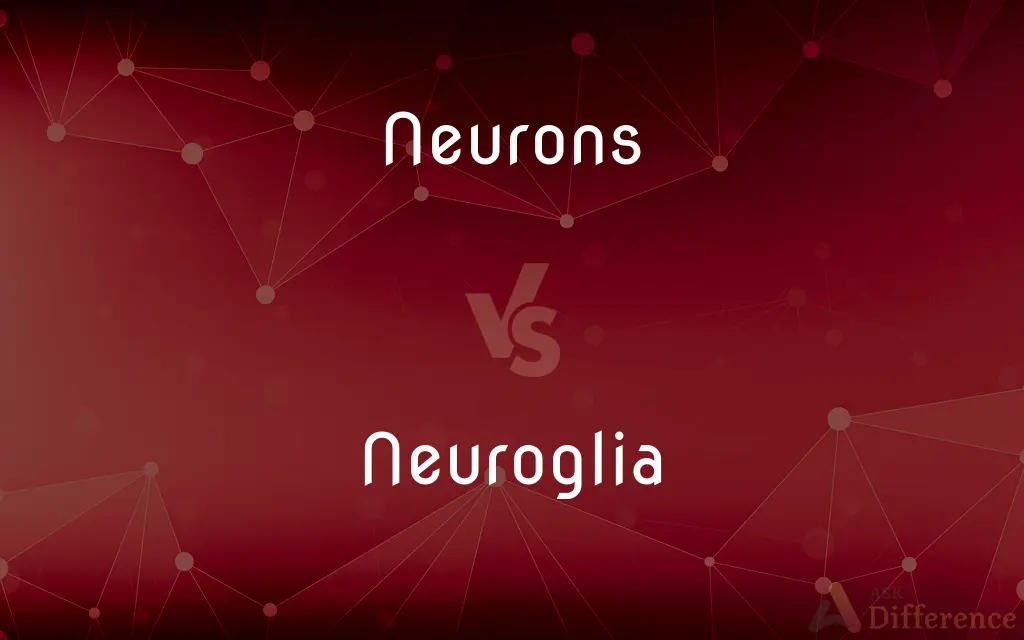Neurons vs. Neuroglia — What's the Difference?
By Urooj Arif & Maham Liaqat — Published on March 11, 2024
Neurons transmit electrical signals throughout the nervous system, while neuroglia support, protect, and maintain the neuronal environment.

Difference Between Neurons and Neuroglia
Table of Contents
ADVERTISEMENT
Key Differences
Neurons are the primary units of communication within the nervous system, conducting electrical impulses that convey information. Neuroglia, in contrast, play a supportive role, providing structural support, nutrition, and protection to neurons, ensuring their optimal function.
Neurons are characterized by their ability to generate and propagate electrical signals known as action potentials. This unique feature enables the nervous system to quickly respond to internal and external stimuli. Neuroglia, however, do not transmit electrical signals but instead contribute to the homeostasis of the neural environment, influencing signal transmission indirectly.
The structure of neurons is specialized for signal transmission, with dendrites receiving signals and axons sending them. Neuroglia, on the other hand, vary in structure depending on their specific functions, which include forming myelin sheaths, regulating extracellular fluid composition, and removing debris.
Neurons rely heavily on neuroglia for survival and function. For instance, oligodendrocytes and Schwann cells form myelin sheaths around axons to insulate them and speed up signal transmission. Without this support, neurons would not function effectively.
The diversity among neuroglia, including astrocytes, microglia, oligodendrocytes, and Schwann cells, reflects their varied roles in the nervous system, from providing metabolic support to participating in immune responses. This diversity underscores the complexity of their functions compared to the more uniform role of neurons in signal transmission.
ADVERTISEMENT
Comparison Chart
Function
Transmit electrical signals
Support, protect, and maintain neurons
Signal Transmission
Capable of generating action potentials
Do not transmit electrical signals
Structural Feature
Have axons and dendrites for signal transmission
Varied structures to perform different functions
Role in Nervous System
Primary signal carriers
Provide structural and metabolic support
Types
Relatively uniform with minor variations
Diverse, including astrocytes, microglia, etc.
Compare with Definitions
Neurons
Neurons are cells that process and transmit information through electrical and chemical signals.
Sensory neurons convey signals from sensory organs to the brain.
Neuroglia
Neuroglia are non-neuronal cells that provide support and protection for neurons.
Astrocytes regulate the chemical environment around neurons.
Neurons
Neurons communicate at synapses through neurotransmitters.
Dopamine-releasing neurons are involved in reward and motivation pathways.
Neuroglia
Neuroglia are essential for the homeostasis and defense of the nervous system.
Oligodendrocytes myelinate multiple CNS neurons, insulating their axons.
Neurons
Neurons are classified based on function as sensory, motor, or interneurons.
Interneurons in the brain integrate information from various sources.
Neuroglia
Astrocytes, a type of neuroglia, contribute to blood-brain barrier maintenance and nutrient transport.
Astrocytes help to clear neurotransmitters from synaptic spaces.
Neurons
Each neuron has a cell body, dendrites for receiving signals, and an axon for sending signals.
Motor neurons have long axons to carry signals from the spinal cord to muscles.
Neuroglia
Microglia, the immune cells of the central nervous system, respond to injury and disease.
Microglia become activated in response to brain damage.
Neurons
The action potential of a neuron is a fundamental process for neural communication.
The firing of a neuron in the hippocampus can contribute to memory formation.
Neuroglia
Oligodendrocytes in the CNS and Schwann cells in the PNS myelinate axons, enhancing signal transmission.
Schwann cells facilitate rapid signal transmission in peripheral nerves.
Neurons
Any of the impulse-conducting cells that constitute the brain, spinal column, and nerves in vertebrates, consisting of a nucleated cell body with one or more dendrites and a single axon.
Neuroglia
The supportive tissue of the nervous system, including the network of branched cells in the central nervous system (astrocytes, microglia, and oligodendrocytes) and the supporting cells of the peripheral nervous system (Schwann cells and satellite cells). Also called glia.
Neurons
A similar impulse-conducting cell in invertebrates.In both senses also callednerve cell.
Neuroglia
(cytology) glial cell
Neurons
Plural of neuron
Neuroglia
Sustentacular tissue that surrounds and supports neurons in the central nervous system; glial and neural cells together compose the tissue of the central nervous system
Common Curiosities
What are neurons?
Neurons are the cells responsible for transmitting information through electrical and chemical signals in the nervous system.
How do neurons and neuroglia interact?
Neuroglia provide neurons with structural support, nutrition, and protection, while neurons are responsible for signal transmission.
What is the main function of neuroglia?
Neuroglia support, protect, and maintain the optimal functioning environment for neurons.
Can neuroglia transmit electrical signals?
No, neuroglia do not transmit electrical signals but play a crucial role in supporting those that do.
What is the significance of myelin sheaths?
Myelin sheaths, formed by oligodendrocytes and Schwann cells, insulate axons to speed up electrical signal transmission.
How do microglia contribute to neural health?
Microglia act as the immune cells of the central nervous system, removing debris and protecting against pathogens.
Why are neurons unable to function without neuroglia?
Neurons rely on neuroglia for metabolic support, insulation, and maintaining the extracellular environment.
What types of cells are considered neuroglia?
Neuroglia include astrocytes, microglia, oligodendrocytes, and Schwann cells, each with specific functions.
How do neurons communicate with each other?
Neurons communicate through synapses using chemical messengers called neurotransmitters.
How do sensory neurons differ from motor neurons?
Sensory neurons transmit information from sensory receptors to the brain, while motor neurons convey signals from the brain to muscles.
Do all neurons have the same structure?
While all neurons share basic features like axons and dendrites, their structures can vary significantly depending on their function.
How do Schwann cells differ from oligodendrocytes?
Schwann cells myelinate axons in the peripheral nervous system, while oligodendrocytes perform this function in the central nervous system.
What distinguishes neurons from neuroglia in terms of function?
Neurons are specialized for electrical signal transmission, whereas neuroglia provide essential support functions.
Can neuroglia become dysfunctional?
Yes, dysfunction in neuroglia can lead to neurological diseases and conditions by affecting their support of neurons.
Share Your Discovery

Previous Comparison
Dungeness Crab vs. Snow Crab
Next Comparison
Asset Management vs. Investment ManagementAuthor Spotlight
Written by
Urooj ArifUrooj is a skilled content writer at Ask Difference, known for her exceptional ability to simplify complex topics into engaging and informative content. With a passion for research and a flair for clear, concise writing, she consistently delivers articles that resonate with our diverse audience.
Co-written by
Maham Liaqat















































